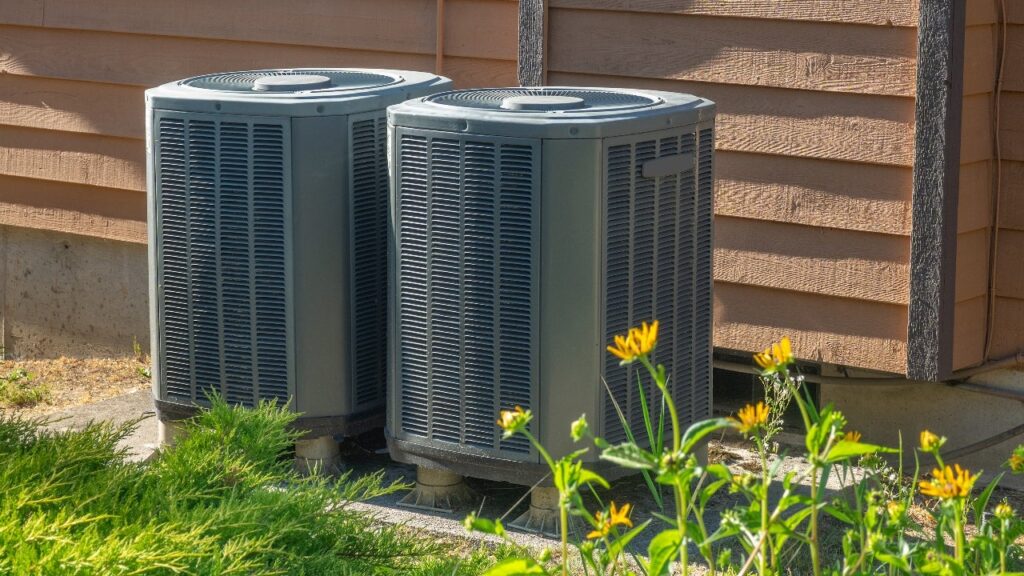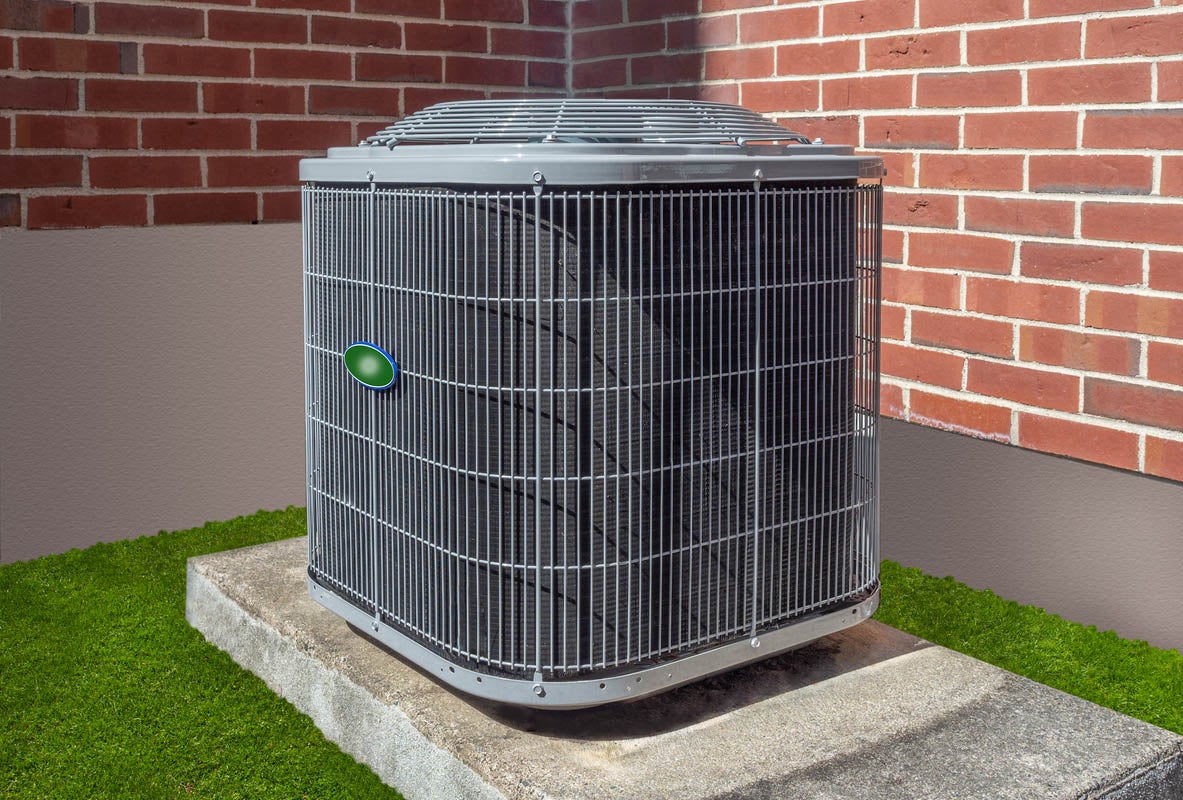Are you curious about the cost of an AC unit? Whether you’re looking to replace your old one or install a new cooling system, it’s essential to know how much you can expect to invest. In this article, we will explore the factors that influence the cost of an AC unit, such as the size of your home, the type of unit you choose, and any additional features you may desire. By the end, you’ll have a better understanding of what to consider when budgeting for an AC unit and make an informed decision that best suits your needs and budget.
Factors Affecting the Cost of an AC Unit
When it comes to purchasing an AC unit, there are several factors that can influence its cost. By understanding these factors, you can make an informed decision and choose the AC unit that best fits your needs and budget.
Type of AC System
The type of AC system you choose will greatly impact the overall cost. There are several types of AC systems available, including central air conditioning, ductless mini-split systems, window AC units, portable AC units, and hybrid AC systems. Each type offers its own set of benefits and price range.
Size of the AC Unit
Another important factor to consider is the size of the AC unit. The size is determined by the cooling capacity required to effectively cool your space. A larger space will require a unit with a higher cooling capacity, which often comes with a higher price tag. It is essential to choose the right size for optimal cooling efficiency and cost-effectiveness.
Energy Efficiency
Energy efficiency is a crucial consideration not only for the environment but also for your wallet. AC units with higher energy efficiency ratings consume less electricity and can save you significant money on your energy bills. While energy-efficient units may have a higher initial cost, they can provide long-term savings and a positive impact on the environment.
Installation Requirements
The installation requirements for an AC unit can also affect its cost. Some types of systems, such as central air conditioning, may require professional installation and the installation of ductwork. This adds to the overall cost. On the other hand, window AC units and portable AC units usually have simpler installation processes and can be installed without professional help, reducing the installation expenses.
Additional Features
AC units can come with various additional features, such as programmable thermostats, remote controls, air purifiers, and dehumidifiers. These features can enhance your comfort and indoor air quality, but they may also add to the cost of the unit. It’s important to consider which features are necessary for your needs and prioritize them accordingly.
Brand and Quality
The brand and quality of the AC unit are factors that can significantly impact its price. Well-known and reputable brands often come with higher price tags, as they have established a reputation for quality and reliability. However, it is important to find a balance between cost and quality, as cheaper brands may not offer the same level of durability and performance.
Warranty
The warranty offered by the manufacturer is an important consideration when purchasing an AC unit. A longer warranty period can provide peace of mind and potentially save you money on repairs or replacement in case of a malfunction. AC units with longer warranties are often priced higher due to the added value they offer.
Geographical Location
Your geographical location can affect the cost of an AC unit in various ways. For example, if you live in an area with a higher cost of living, the overall price of the unit and installation services may be higher. Additionally, certain climates may require more powerful or specialized AC units, leading to higher costs. It’s important to consider your location’s specific needs and consult with professionals when making a decision.
Labor Costs
Labor costs associated with the installation of an AC unit can also impact its total cost. If professional installation is required, it’s essential to consider the rates of HVAC technicians in your area. Labor costs may vary depending on the complexity of the installation, the type of AC system, and local market conditions. Obtaining quotes from multiple reputable contractors can help you make an informed decision.
Maintenance and Repair
Lastly, the cost of maintenance and repair should not be overlooked when considering the overall expense of an AC unit. Regular maintenance, such as cleaning and inspections, is essential for optimal performance and longevity. Additionally, unexpected repairs and part replacements may be necessary throughout the unit’s lifespan. Considering these ongoing costs can help you assess the long-term investment of an AC unit.
Different Types of AC Systems and Their Costs
Understanding the different types of AC systems available along with their costs can help you narrow down your options and choose the most suitable one for your needs. Here are the main types of AC systems and a breakdown of their average costs:
Central Air Conditioning
Central air conditioning systems are designed to cool the entire home or building by distributing cool air through a network of ducts. The cost of a central air conditioning system can vary depending on factors such as the size of the home, the type of compressor used, and the additional features included. On average, the cost of a central air conditioning system can range from $2,500 to $7,500, including installation.
Ductless Mini-Split System
Ductless mini-split systems are a popular choice for homes without existing ductwork. These systems consist of an outdoor unit and one or more indoor units, allowing for individual temperature control in different areas of the home. The cost of a ductless mini-split system depends on factors like the number of indoor units needed, the size and capacity of the system, and the additional features included. On average, the cost of a ductless mini-split system can range from $2,000 to $10,000, including installation.
Window AC Units
Window AC units are a cost-effective option for cooling individual rooms or small spaces. These units are designed to fit into a standard window frame and can be easily installed without professional help. The cost of a window AC unit depends on factors such as the BTU (British Thermal Units) output, energy efficiency rating (EER), and additional features. On average, the cost of a window AC unit can range from $100 to $1,000.
Portable AC Units
Portable AC units offer flexibility and mobility as they can be moved easily from one room to another. These units typically come with a window installation kit and can be used in apartments or spaces where window installations are not possible. The cost of a portable AC unit depends on factors such as the BTU output, energy efficiency rating (EER), portability, and additional features. On average, the cost of a portable AC unit can range from $200 to $800.
Hybrid AC Systems
Hybrid AC systems combine the benefits of both central air conditioning and heat pump systems. These systems are designed to provide efficient cooling in the summer and heating in the winter. The cost of a hybrid AC system can vary depending on factors such as the type of hybrid system chosen, the size and capacity of the system, and the energy efficiency rating (SEER and HSPF). On average, the cost of a hybrid AC system can range from $3,000 to $8,000, including installation.
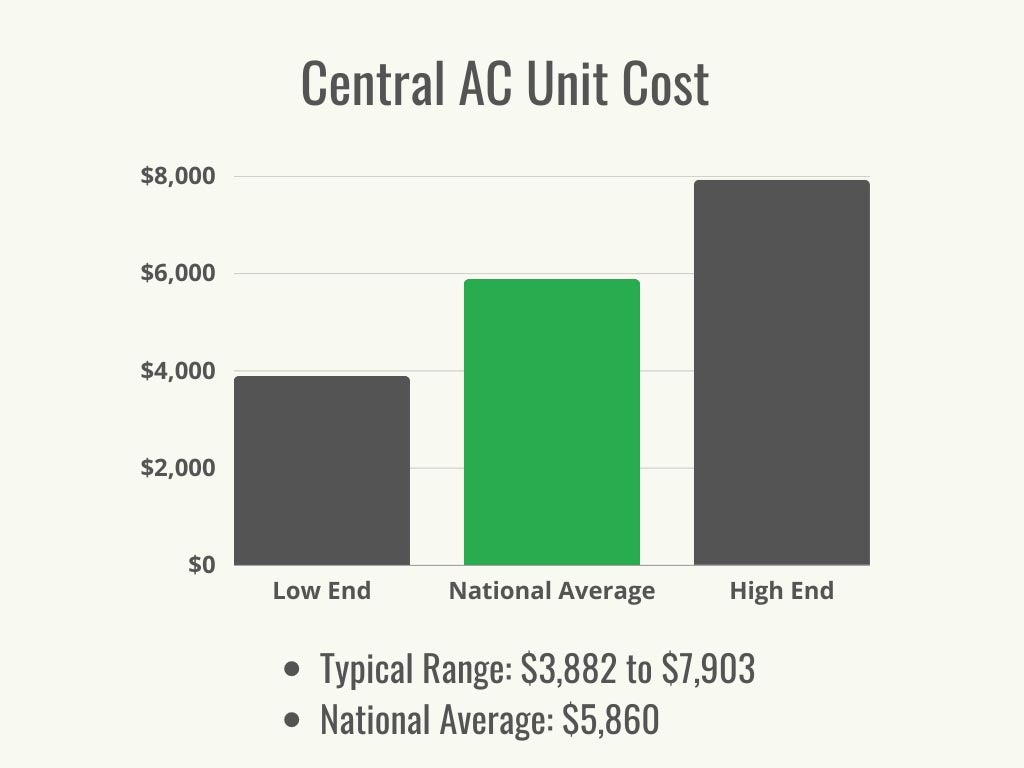
Average Cost Range for AC Units
To give you a better idea of the average cost range for AC units, here is a breakdown of the estimated costs for each type discussed above:
Central Air Conditioning: $2,500 – $7,500
Ductless Mini-Split System: $2,000 – $10,000
Window AC Units: $100 – $1,000
Portable AC Units: $200 – $800
Hybrid AC Systems: $3,000 – $8,000
It’s important to note that these cost ranges are estimates and can vary depending on factors such as the specific requirements of your space, the brand and quality of the AC unit, and the labor costs associated with installation. Obtaining quotes from reputable HVAC professionals is recommended for a more accurate assessment of the costs involved in your specific situation.
Factors Influencing the Cost of Central Air Conditioning
Central air conditioning systems are a popular choice for cooling entire homes or buildings. The cost of a central air conditioning system can vary based on the following factors:
Type of Central AC System
There are different types of central AC systems to choose from, including split systems, packaged units, and geothermal systems. Split systems are the most common and often the most affordable option. Packaged units are compact and suitable for homes without available attic or basement space. Geothermal systems, while highly efficient, are usually more expensive due to the complexity of the installation. The type of central AC system you choose will impact the overall cost.
Size of the AC Unit
The size of the AC unit is determined by the cooling capacity required to effectively cool your home. A unit that is too small will struggle to cool the space, while a unit that is too large may cycle on and off frequently, resulting in inefficient operation. HVAC professionals consider factors such as the size of the home, insulation levels, and the number of windows when determining the appropriate size. The size of the AC unit will influence the cost, with larger units generally priced higher.
Energy Efficiency Rating (SEER)
The energy efficiency rating of a central AC system is measured by its SEER (Seasonal Energy Efficiency Ratio). Higher SEER ratings indicate greater energy efficiency. While units with higher SEER ratings may have a higher upfront cost, they can deliver long-term savings by reducing energy consumption and lowering utility bills. It’s important to find the right balance between the upfront cost and long-term energy savings when considering the SEER rating.
Ductwork Installation
Central air conditioning systems require a network of ducts to distribute the cool air throughout the home. If your home does not have existing ductwork, the installation of ducts can add to the overall cost. Factors such as the size and complexity of the ductwork, as well as any modifications or repairs needed, can influence the total cost. It’s essential to consider these additional expenses when budgeting for a central AC system.
Additional Features and Accessories
Central AC systems can come with various additional features and accessories that enhance comfort and convenience. These may include programmable thermostats, zoning systems, air purifiers, and humidity control features. While these features can improve your overall indoor experience, they may also increase the cost of the system. It’s important to assess which features are necessary for your needs and budget accordingly.
Considering these factors and consulting with HVAC professionals can help you determine the cost of a central air conditioning system that meets your specific requirements. The expertise of professionals can also ensure that the unit is properly sized and installed for optimal performance and efficiency.
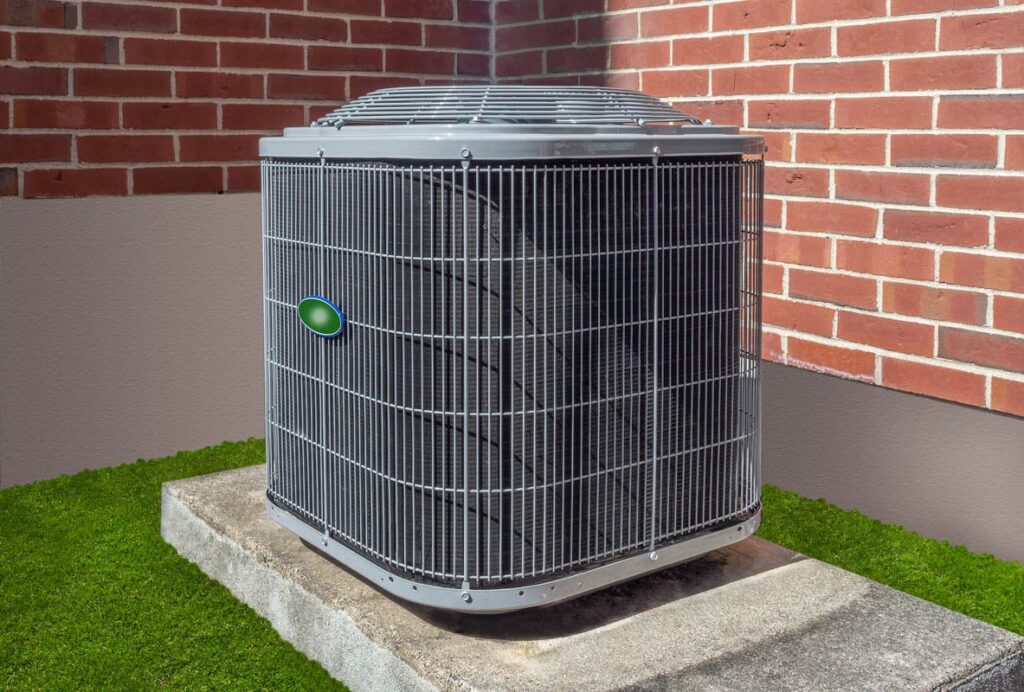
Factors Influencing the Cost of Ductless Mini-Split System
Ductless mini-split systems offer a versatile and efficient cooling solution for homes without existing ductwork. The cost of a ductless mini-split system can be influenced by the following factors:
Number of Indoor Units
Ductless mini-split systems consist of one outdoor unit connected to one or multiple indoor units. Each indoor unit can cool a specific area or room independently. The number of indoor units required will depend on the size and layout of your home. The more indoor units needed, the higher the overall cost of the system.
Size and Capacity of the System
Similar to central air conditioning, the size and capacity of a ductless mini-split system play a role in its cost. The cooling capacity required is determined by factors such as the size of the area to be cooled, insulation levels, and the number of windows. HVAC professionals can assess these factors to determine the appropriate size and capacity, which will impact the cost of the system.
Energy Efficiency Rating (SEER and HSPF)
Ductless mini-split systems have both SEER (Seasonal Energy Efficiency Ratio) and HSPF (Heating Seasonal Performance Factor) ratings. Higher ratings indicate greater energy efficiency. While units with higher SEER and HSPF ratings may have a higher initial cost, they can provide long-term savings by reducing energy consumption. Considering the energy efficiency ratings of a ductless mini-split system is essential for cost-effective and environmentally-friendly cooling.
Installation Complexity
The complexity of the installation process can influence the overall cost of a ductless mini-split system. Factors such as the distance between the outdoor unit and indoor units, the accessibility of the installation location, and any required modifications to the space can impact the installation complexity. More complex installations may require additional labor and materials, thereby increasing the overall cost.
Additional Features and Accessories
Ductless mini-split systems can come with additional features and accessories to enhance functionality and convenience. These may include wireless remote controls, programmable timers, and air purifiers. While these features can improve your overall comfort and air quality, they may also add to the total cost of the system. It’s important to evaluate which features are essential for your needs and factor them into your budget.
By considering these factors and consulting with HVAC professionals, you can determine the cost of a ductless mini-split system that best suits your needs and budget. HVAC professionals can provide accurate assessments and proper installation to ensure optimal performance and energy efficiency.
Factors Influencing the Cost of Window AC Units
Window AC units are a popular option for cooling individual rooms or small spaces. The cost of a window AC unit can be influenced by the following factors:
BTU Output
The BTU (British Thermal Units) output of a window AC unit determines its cooling capacity. Higher BTU ratings indicate a greater cooling capacity. The size of the room or space you wish to cool will determine the appropriate BTU output. Units with higher BTU outputs generally have a higher cost. It’s important to choose a window AC unit with an appropriate BTU rating for effective and efficient cooling.
Energy Efficiency Rating (EER)
The energy efficiency rating of a window AC unit is measured by its EER (Energy Efficiency Ratio). Higher EER ratings indicate greater energy efficiency. Units with higher EER ratings may have a higher upfront cost, but they can provide long-term savings by reducing energy consumption. Consider balancing the initial cost with potential energy savings when selecting a window AC unit.
Installation Requirements
The installation of a window AC unit is relatively simple and can often be done without professional help. However, certain installation requirements may affect the overall cost. Factors such as the availability of a suitable window and the need for additional support brackets or sealing materials can add to the installation expenses. It’s important to consider these requirements when budgeting for a window AC unit.
Additional Features and Accessories
Window AC units can come with additional features and accessories that enhance functionality and convenience. These may include remote controls, programmable timers, sleep modes, and air filters. While these features can improve your overall experience, they may also increase the cost of the unit. Consider which features are essential for your needs and allocate your budget accordingly.
By considering these factors, you can determine the cost of a window AC unit that meets your cooling needs and fits your budget. It’s important to choose a unit that offers the appropriate BTU output, energy efficiency, and necessary features to ensure optimal performance and comfort.
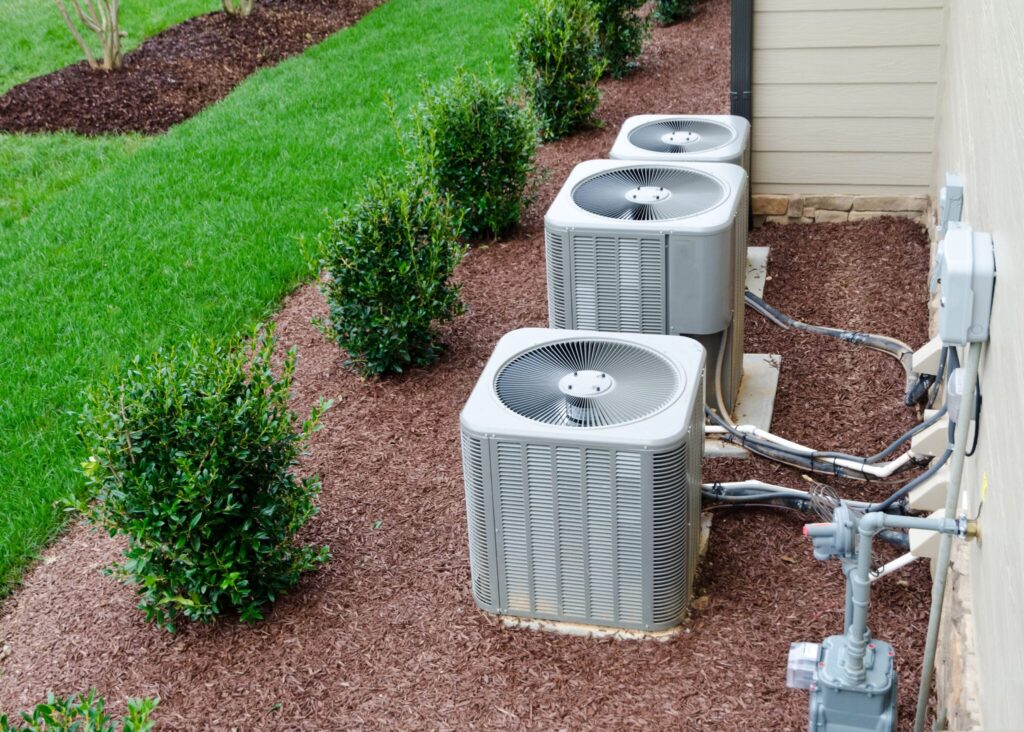
Factors Influencing the Cost of Portable AC Units
Portable AC units offer flexibility and mobility, making them a popular choice for cooling individual rooms or spaces. The cost of a portable AC unit can be influenced by the following factors:
BTU Output
The BTU (British Thermal Units) output of a portable AC unit determines its cooling capacity. Higher BTU ratings indicate a greater cooling capacity. The size of the room or space you wish to cool will determine the appropriate BTU output. Portable AC units with higher BTU outputs generally have a higher cost. It’s important to select a unit with the right BTU rating for efficient cooling.
Energy Efficiency Rating (EER)
The energy efficiency rating of a portable AC unit is measured by its EER (Energy Efficiency Ratio). Higher EER ratings indicate greater energy efficiency. Units with higher EER ratings may be priced higher initially, but they can provide long-term energy savings. Consider the balance between the upfront cost and potential energy savings when choosing a portable AC unit.
Portability and Mobility
The portability and mobility of a portable AC unit are important factors to consider. Units with additional features like caster wheels, handles, and compact designs tend to be more expensive. These features allow for easier transportation and positioning of the unit within different rooms or spaces. Consider your specific needs for portability and mobility when evaluating costs.
Installation Requirements
The installation of a portable AC unit is typically straightforward and can be done without professional help. However, specific installation requirements may affect the overall cost. For instance, units with dual-hose designs may have a higher price compared to single-hose models. Dual-hose designs provide more efficient cooling while minimizing negative air pressure and reducing the infiltration of warm air. Consider these installation requirements when budgeting for a portable AC unit.
Additional Features and Accessories
Portable AC units can come with additional features and accessories to enhance functionality and convenience. These may include remote controls, programmable timers, sleep modes, and air purifiers. While these features can improve your overall experience, they may also increase the cost of the unit. It’s important to evaluate which features are necessary for your needs and allocate your budget accordingly.
By considering these factors, you can determine the cost of a portable AC unit that suits your cooling needs and budget. It’s essential to select a unit with the appropriate BTU output, energy efficiency, and necessary features to ensure optimal cooling performance.
Factors Influencing the Cost of Hybrid AC Systems
Hybrid AC systems combine the benefits of both central air conditioning and heat pump systems. The cost of a hybrid AC system can be influenced by the following factors:
Type of Hybrid System
There are different types of hybrid AC systems available, including packaged hybrid systems and split hybrid systems. Packaged hybrid systems combine the components of both central air conditioning and heat pumps into a single outdoor unit. Split hybrid systems consist of separate outdoor units for the cooling and heating functions. The type of hybrid system you choose will impact the overall cost.
Size and Capacity of the System
Similar to other AC systems, the size and capacity of a hybrid AC system play a role in its cost. The size and capacity are determined by factors such as the cooling and heating requirements of the space, insulation levels, and the number of windows. HVAC professionals can assess these factors to determine the appropriate size and capacity, which will impact the cost of the system.
Energy Efficiency Rating (SEER and HSPF)
Hybrid AC systems have both SEER (Seasonal Energy Efficiency Ratio) and HSPF (Heating Seasonal Performance Factor) ratings. Higher ratings indicate greater energy efficiency. Units with higher SEER and HSPF ratings will generally have a higher initial cost but can provide long-term savings by reducing energy consumption. Considering the energy efficiency ratings of a hybrid AC system is essential for cost-effective cooling and heating.
Installation Complexity
The complexity of the installation process can affect the cost of a hybrid AC system. Factors such as the type of hybrid system chosen, the size and number of outdoor units, and any required modifications to the space can influence the installation complexity. More complex installations may require additional labor and materials, thereby increasing the overall cost.
Additional Features and Accessories
Hybrid AC systems can come with additional features and accessories to enhance functionality and convenience. These may include programmable thermostats, zone control systems, air purifiers, and humidity control features. While these features can improve your overall indoor experience, they may also add to the total cost of the system. Evaluate which features are essential for your needs and consider them in your budget.
Considering these factors and consulting with HVAC professionals can help you determine the cost of a hybrid AC system that meets your specific requirements. HVAC professionals can provide accurate assessments and proper installation to ensure optimal performance, energy efficiency, and cost-effectiveness.

Popular AC Brands and Their Price Range
When shopping for an AC unit, it’s important to consider reputable brands known for their quality and reliability. Here are some popular AC brands along with their price ranges:
Carrier
Carrier is a well-known brand in the HVAC industry, offering a wide range of AC units. The cost of Carrier AC units can vary depending on factors such as the type of system (central air conditioning or ductless mini-split), the cooling capacity, and additional features. On average, Carrier AC units can range from $3,000 to $8,000, including installation.
Trane
Trane is another reputable brand that offers high-quality AC units. Trane AC units are known for their durability and energy efficiency. The cost of Trane AC units can range from $3,000 to $7,500, including installation. Factors like the type of system, size, energy efficiency rating, and additional features can influence the overall cost.
Lennox
Lennox is a brand known for its innovative and energy-efficient AC units. Lennox AC units offer advanced technologies and superior performance. The cost of Lennox AC units can range from $2,500 to $7,500, including installation. The specific model, size, energy efficiency rating, and additional features can impact the price.
Rheem
Rheem is a reliable brand that offers a wide range of AC units suitable for various needs. Rheem AC units are known for their durability and energy efficiency. The cost of Rheem AC units can range from $2,500 to $6,500, including installation. Factors like the specific model, size, energy efficiency rating, and additional features can influence the total cost.
Daikin
Daikin is a global leader in the HVAC industry, offering a comprehensive range of AC units. Daikin AC units are known for their excellent energy efficiency and innovative features. The cost of Daikin AC units can range from $3,000 to $10,000, including installation. Factors like the type of system, size, energy efficiency rating, and additional features can impact the price.
Mitsubishi Electric
Mitsubishi Electric is a renowned brand known for its high-quality ductless mini-split systems. Mitsubishi Electric AC units offer superior performance and energy efficiency. The cost of Mitsubishi Electric AC units can range from $2,000 to $10,000, including installation. Factors like the number of indoor units, size and capacity, energy efficiency rating, and additional features can influence the overall cost.
Goodman
Goodman is a reliable brand that offers affordable AC units without compromising on quality. Goodman AC units are known for their durability and reliability. The cost of Goodman AC units can range from $2,000 to $6,000, including installation. The specific model, size, energy efficiency rating, and additional features can impact the price.
York
York is a trusted brand that offers a wide range of AC units suitable for different budgets. York AC units are known for their reliability and energy efficiency. The cost of York AC units can range from $2,500 to $6,500, including installation. Factors like the specific model, size, energy efficiency rating, and additional features can influence the total cost.
Bryant
Bryant is a brand that offers a diverse selection of AC units with a focus on energy efficiency. Bryant AC units are known for their reliable performance and durability. The cost of Bryant AC units can range from $2,500 to $7,500, including installation. Factors like the type of system, size, energy efficiency rating, and additional features can impact the price.
American Standard
American Standard is a reputable brand that offers innovative and energy-efficient AC units. American Standard AC units are designed for optimal performance and comfort. The cost of American Standard AC units can range from $3,000 to $8,000, including installation. Factors like the specific model, size, energy efficiency rating, and additional features can influence the total cost.
When considering AC brands, it’s crucial to assess your specific cooling needs, budget, and desired features. Consulting with HVAC professionals can help you determine the brand and model that best fits your requirements.
Importance of Maintenance and Repair Costs
When calculating the cost of an AC unit, it’s essential to consider the ongoing maintenance and repair costs associated with owning and operating the system. Neglecting these costs can result in unexpected expenses and potentially impact the lifespan and performance of your AC unit. Here are some key points to consider:
Regular Maintenance
Regular maintenance is vital for ensuring the optimal performance and longevity of your AC unit. It involves tasks such as cleaning or replacing filters, inspecting and cleaning coils, checking refrigerant levels, and verifying electrical connections. While some maintenance tasks can be performed by homeowners, it’s recommended to have a professional HVAC technician perform a comprehensive maintenance check at least once a year. The cost of professional maintenance services can range from $75 to $200, depending on the complexity of the task and the location.
Repair and Replacement
Over time, AC units may require repairs due to normal wear and tear or unexpected malfunctions. The cost of repairs can vary greatly depending on the nature of the issue and the parts needed. Minor repairs like replacing a fan motor or a capacitor can cost between $100 and $500. However, more significant repairs, such as replacing a compressor or condenser coil, can cost anywhere from $1,000 to $2,500. In some cases, it may be more cost-effective to replace an older or inefficient unit rather than repairing it repeatedly. Considering the potential repair and replacement costs is important when assessing the long-term investment of an AC unit.
Extended Warranty and Service Contracts
To protect your investment and mitigate potential repair costs, it’s worth considering extended warranties and service contracts. Extended warranties provide additional coverage beyond the manufacturer’s warranty and can cover parts and labor for a certain period. The cost of extended warranties can range from $100 to $500, depending on the coverage and duration. Service contracts offer regular maintenance and discounted repair services for a specified period. These contracts can help alleviate the burden of unexpected repair costs and provide peace of mind. The cost of service contracts varies depending on the coverage and the service provider.
Finding Certified Technicians
When it comes to maintenance and repairs, it’s important to find certified HVAC technicians with experience and expertise. Hiring qualified professionals ensures that the work is done correctly and efficiently, minimizing the risk of further damage or system performance issues. It’s recommended to research local HVAC companies, read customer reviews, and verify their certifications before hiring. While certified technicians may charge slightly higher rates, their expertise can save you money in the long run by preventing costly mistakes and ensuring the optimal functioning of your AC unit.
By considering these factors and budgeting for ongoing maintenance and repair costs, you can make a more accurate assessment of the total cost of owning an AC unit. Regular maintenance, timely repairs, and professional assistance can help you maximize the lifespan and efficiency of your unit, providing reliable cooling for years to come.
